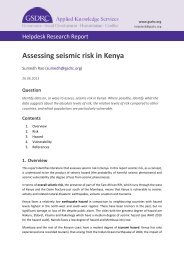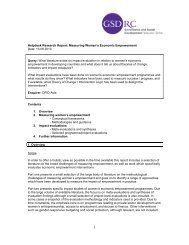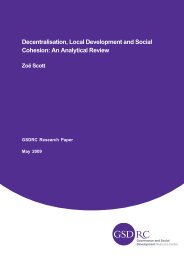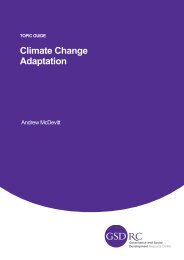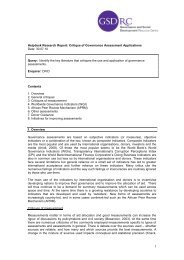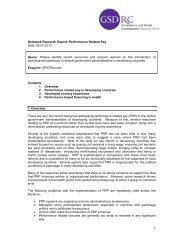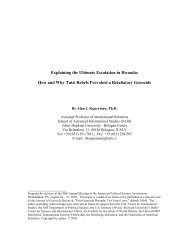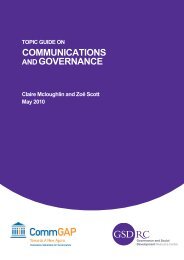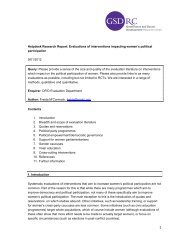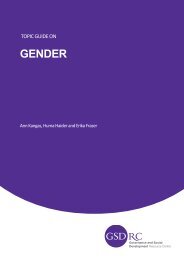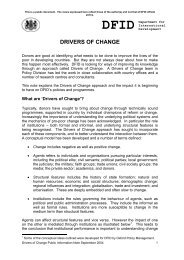De Coning, C. and Romita, P. 2009, ‘Monitoring and Evaluation of Peace Operations’ International Peace Institute, NewYorkhttp://www.gsdrc.org/go/display&type=Document&id=3777It is difficult to make causal linkages between inputs and outcomes due to the complex nature of conflict. Donor countriesand NGOs would do better to focus instead on the contributions particular activities make towards a desired outcome.Sustainable DDR requires achievements in other areas. DDR evaluation should look across a variety of sectors and considerthe political dynamics that affect DDR processes. Identifying M&E benchmarks and indicators can help reconcile competingperspectives of strategic decisions. Other suggestions to improve M&E are: a web-based database of M&E lessons learned;a network to debate M&E issues; policy discussions on M&E at high profile discussion-making forums; and mechanisms toensure that M&E results are incorporated into decision-making processes.Church, C. and Rogers, M. M., 2006, ‘Designing for Results: Integrating Monitoring and Evaluation in ConflictTransformation Programs’, Search for Common Ground, Washington DChttp://www.sfcg.org/programmes/ilr/ilt_manualpage.htmlStabilisationCohen, C., 2006, ‘Measuring Progress in Stabilisation and Reconstruction’, Special Report, United States Institute ofPeace, Washington DChttp://www.gsdrc.org/go/display&type=Document&id=3663Measuring progress is essential to the success of stabilisation and reconstruction efforts. This report examines theshortcomings of current processes, including the tendency to measure implementation rather than impact. Properassessment tools and reliable measures of progress are needed to enable policymakers to take stock of the challengesbefore intervening and to continuously track the progress of their efforts towards stabilisation. Political will is also essentialto ensure leadership and cooperation across organisational boundariesFor more detailed guidance on measuring and assessing fragility, see the <strong>GSDRC</strong>'s Fragile States Topic Guide:http://www.gsdrc.org/go/fragile-states/chapter-3--measuring-and-assessing-fragility/measuring-fragilityM&E of empowerment and accountabilityDonors have been increasingly concerned with empowering poor people in their economic, social and politicalrelationships, and ensuring that their programmes (and the governments that they support) are accountable tobeneficiaries. These processes are complex and can be difficult to measure. There is a tension for donors between the needto pursue a flexible approach to supporting empowerment processes and the need to demonstrate results andaccountability to their constituents. Combining quantitative and qualitative methods and using locally-generated indicatorscan help to overcome some of these issues.A growing number of studies have sought to use Randomised Control Trials to measure empowerment and accountabilityprocesses and programmes. The following report outlines some of the key challenges associated with using RCTs for theseprogrammes and notes that scholars are divided about the ability of these methods to generate reliable results.<strong>GSDRC</strong>, 2011, ‘RCTs for Empowerment and Accountability Programmes’, Helpdesk Research Report, Governance andSocial Development Resource Centre, University of Birminghamhttp://www.gsdrc.org/docs/open/HD756.pdfThis report examines the extent to which RCTs have been used successfully to measure empowerment and accountabilityprocesses and programmes. Field experiments present immense opportunities, but they are more suited to measuringshort-term results with short causal chains and less suitable for complex interventions. The studies have also demonstrateddivergent results, possibly due to different programme designs. The literature highlights that issues of scale, context,complexity, timeframe, coordination and bias in the selection of programmes also determine the degree of successreported. It argues that researchers using RCTs should make more effort to understand contextual issues, consider howexperiments can be scaled up to measure higher-order processes, and focus more on learning. The report suggestsstrategies such as using qualitative methods, replicating studies in different contexts and using randomised methods withfield activities to overcome the limitations in the literature.McGee, R., and Gaventa, J., 2011, 'Shifting Power? Assessing the Impact of Transparency and Accountability', WorkingPaper No. 383, Institute of Development Studies, Brightonhttp://www.gsdrc.org/go/display&type=Document&id=4209What does impact mean in relation to accountability programmes and projects? This paper argues that current approachesto impact assessment in this field are inadequate: methodological wars are overshadowing key issues of power relationsand politics. A learning approach to impact assessment is needed that gives power and politics a central place inmonitoring and evaluation systems. Instead of looking at the extent to which the desired impact was achieved, it isimportant to look at what happened as a result of the initiative, how it happened and why. It is also important to test and23 <strong>GSDRC</strong>, 2012, Topic Guide on Measuring Results
evise assumptions about theories of change continually and to ensure the engagement of marginalised people inassessment processes.A more detailed discussion of measuring impact and change in empowerment and accountability programmes is providedin the ‘Empowerment and Accountability’ Topic Guide:http://www.gsdrc.org/go/topic-guides/empowerment-and-accountability/measuring-empowerment-and-accountabilityM&E of policy influenceInfluencing policy has become increasingly central in the development strategies of aid agencies and NGOs. Monitoringadvocacy is challenging, however, because these interventions are highly complex and involve a range of interacting forcesand actors. Key responses to these challenges include developing a theory of change, user surveys and collecting significantchange stories.Jones, H., 2011, 'A Guide to Monitoring and Evaluating Policy Influence', Background Note, Overseas DevelopmentInstitute, Londonhttp://www.gsdrc.org/go/display&type=Document&id=4096Is it possible to monitor and evaluate effectively efforts to influence policy? This paper provides an overview of approachesto the monitoring and evaluation (M&E) of policy influencing activities. It suggests that while M&E in this field ischallenging, information can be generated that can be used to improve programmes and provide accountability for funds.The key is for policy influencing teams to recognise the value of M&E to their work and to incorporate it into their practicesfrom the beginning of a project or programme.M&E in governance and social development sub-sectorsFor brief overviews of some of the specific issues associated with M&E in key governance and social development subsectors,see the following sections in other <strong>GSDRC</strong> Topic Guides.Monitoring and Evaluating Institutional ChangeThe European Foundation for Quality Management (EFQM) Excellence Modelhttp://www.efqm.org/en/tabid/132/default.aspxDFID promotes the use of the European Foundation for Quality Management (EFQM) Excellence Model, which provides aframework for assessing the aspects of performance that make an organisation successful.The model was designed to be a generic model and is as applicable to 'non-business' oriented organisations such asgovernment departments and agencies and non-profit organisations as to private sector organisations. It recognises thatthere are many approaches to achieving sustainable excellence in organisations, and provides considerable freedom forinterpretation to reflect strategies which are appropriate for an individual public sector entity given where it has comefrom, the cultural climate, country diversity, modernisation progress, and political climate. It can be used to helporganisations recognise institutional issues that must be addressed as well as provide measures for evaluating the impactof change on performance.Monitoring and Evaluating Human Rights ProgrammesA key concern is assessing the intentional and unintentional effects (positive or negative) of a human rights programme.This has been developed further by approaches which use impact assessments to monitor and evaluate the impact ofhuman rights interventions and/or the human rights components of interventions. Thinking about impact is also thought tocontribute to awareness about human rights concerns, and therefore facilitate the integration of rights-based principlesinto the overall policy process.Department for International Development, 2009, ‘How to Note: A Practical Guide to Assessing and Monitoring HumanRights in Country Programmes’, DFID, Londonhttp://www.stabilisationunit.gov.uk/stabilisation-and-conflict-resources/thematic/doc_details/303-how-to-note-apractical-guide-to-assessing-and-monitoring-human-rights-in-country-programmes-.htmlHarrison, J., 2010, 'Measuring Human Rights: Reflections on the Practice of Human Rights Impact Assessment andLessons for the Future', Warwick School of Law Research Paper No. 2010/26, University of Warwickhttp://www.gsdrc.org/go/display&type=Document&id=4226This study examines the practice of Human Rights Impact Assessment (HRIA). It argues that, while a uniform HRIA processin all fields will not be appropriate, eight core elements represent the 'minimum core' of a valid process: screening,scoping, evidence gathering, consultation, analysis, producing policy-oriented recommendations, publication, andmonitoring and review. Overall, better performance monitoring is crucial, and the people undertaking HRIAs need a deepApplying monitoring and evaluation tools 24



